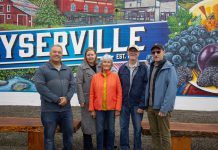Citing the need for affordable housing and the prohibitive costs of requisite renovations, the Town of Windsor will proceed with high-density mixed-use development plans at the Bluebird Center site.
Following a request by the town council to consider the property, a former church campus with four buildings, as a potential rec center site, council members directed staff to move forward with affordable housing development plans intended at the time of the purchase.
The town acquired the property on Bluebird Drive and Old Redwood Highway — once the New Song Church — in 2018, with plans to facilitate development of a housing/mixed-use project. Since its acquisition, however, the site has been rebranded as a community center, with one of its four buildings tapped for various events and trainings, and, until recently, as a COVID-19 testing center.
Because of interest in a new community center in the time since the acquisition, the council directed city staff to provide an informational report on the relative values of developing as planned, or retaining the complex for recreational use.
According to Parks and Recreation Director Jon Davis, the buildings and playground equipment would require cost-prohibitive renovations to make the complex feasible for long-term recreational use. Excluding the former center of worship currently in use, the buildings have problems like mold and lack of ADA-compliance.
Remedying safety problems in the playground area would require removing the concrete foundation and extending the fence into the driveway area, a discovery that dashed earlier considerations that the campus could be adapted into a preschool.
Despite its problems, Davis said his department had been excited about the property as an opportunity to provide more programs for the community.
“We have been utilizing the space that is compliant to this date, but we did find after further review that were some definite roadblocks to utilize the property in its entirety in its current form,” Davis said.
Necessary renovations on the largest of buildings would cost between $55,000 and $72,000. It’s possible that the building now in use could be incorporated into any new development, while the others would be demolished.
Community Development Director Jessica Jones said the site is best utilized for development in its current zoning designation — high-density mixed use.
Jones said the property is an optimal location for residential development per the town’s “smart growth” philosophy, which emphasizes a departure from isolated single-family suburban developments in favor of compact development patterns that promote residents to walk and use mass transit, reducing environmental and other impacts.
“We have a small number of properties located outside of but close to the downtown area which are already designated for higher density, and which have proximity to a range of services and amenities. This makes it better suited for housing than recreational purposes,” Jones said.
Jones said the affordable housing development on the property will be essential to meeting the town’s RHNA numbers. With recent changes to legislation disqualifying certain properties from satisfying RHNA requirements, it’s all the more important the Bluebird property be developed as originally planned.
In California, cities are assigned RHNA — or Regional Housing Needs Allocation — numbers; that is, the number of new units that must be developed per eight-year cycle. Reaching RHNA requirements is a necessary condition to key funding mechanisms.
The next eight-year cycle, which begins with the update of the housing element in the general plan in 2023, calls for 994 new housing units in Windsor — a 126% increase over requirements of the last cycle.
Cities face particular difficulty meeting affordable housing requirements, and the Bluebird property as currently zoned could provide 65 or more units in that income category.
Staff estimated that the property, for which they will now begin seeking developers, could see a concrete proposal sometime next year.









